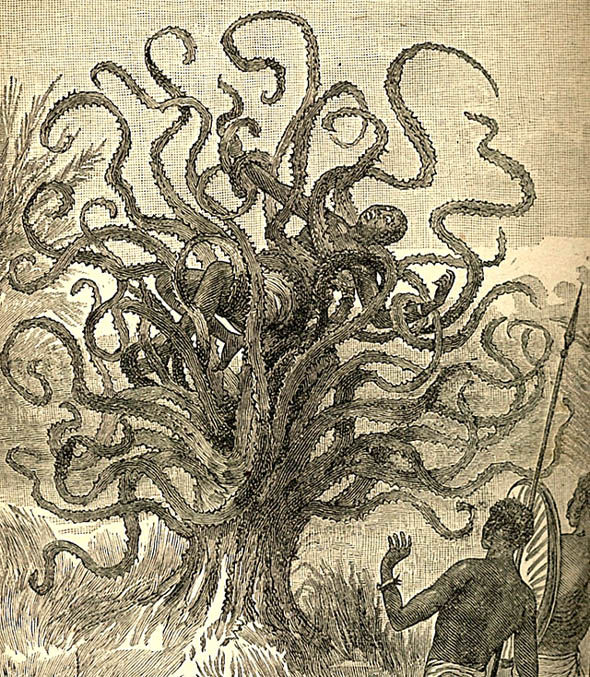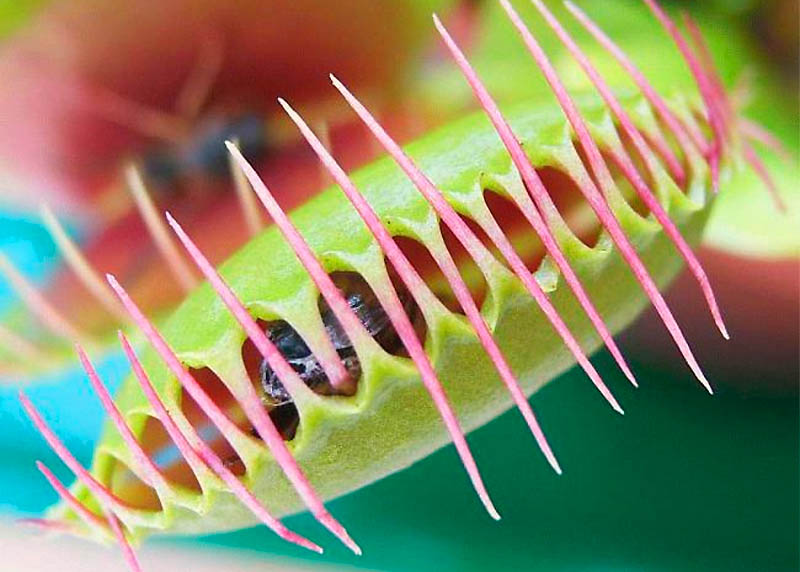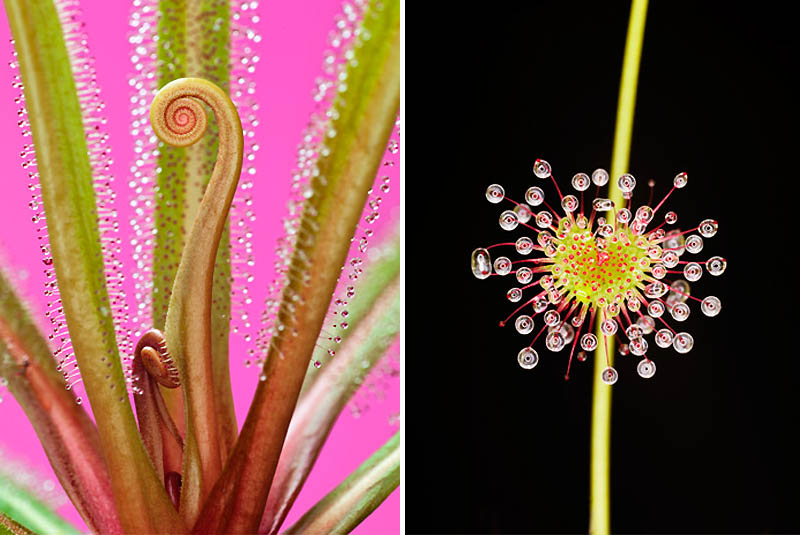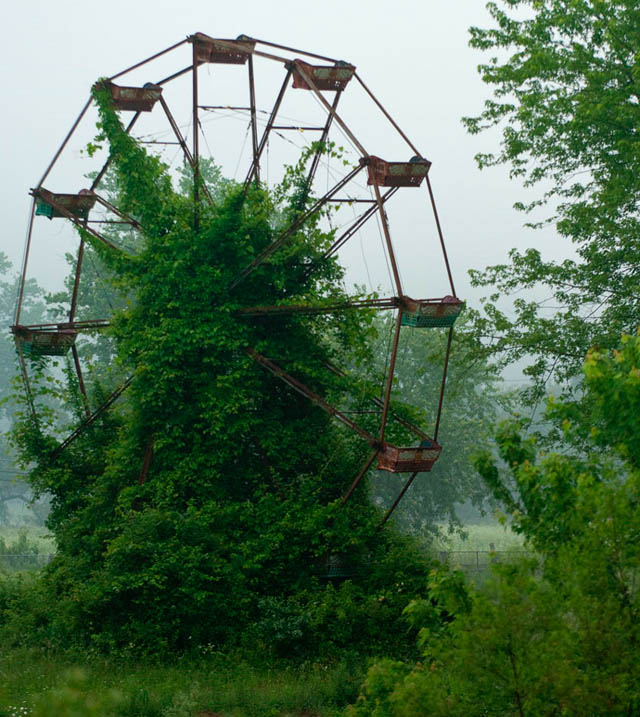|
View: 2369|Reply: 5
|
Tumbuhan Pemakan Serangga & Binatang Kecil.
[Copy link]
|
|
|
Carnivorous Plants: Hungry & Gorgeous
 [size=78%]"QUANTUM SHOT" #654 [size=78%]"QUANTUM SHOT" #654
Link - article by M. Christian and A. Abrams
Passive-Aggressive, Green and Very Hungry!
You have to admit, it does make a kind of twisted sense: After all, we've been feasting on their fibrous, nutrition-packed stems, leaves, tubers, and fruits since we began to actually eat the salad that came with our steaks so, naturally, there must have been a certain ... well, 'desire' for reciprocity. In other words if we eat them why shouldn't they want to eat us?


(images via)
For all you geeks out there – and, yes, we know who you are – it's commonly thought that the first depiction of a salad making a meal out of a man comes from Dr. Carl Liche, writing in 1881. J.W. Buel echoed the idea in his Land and Sea in 1887 (see below). Unluckily for Liche and Buel they've been since exposed as 'imaginative' instead of 'accurate.' ("The Day of the Triffids" by John Wyndham also deserves a mention). Hate to disappoint but true man-eating plants are a total myth:

(image via, click to enlarge)
But that doesn't mean that the next time you sit down to feast on a supposedly defenseless potato there aren't other forms of plant life that are also having a tasty meal of, while not us humans, then most definitely other animals – and sometimes rather large animals.

(images credit: Barry Rice, 2)
Venus Entrapment
The poster-plant for botanical carnivores has got to be the legendary Venus Flytrap. A resident of swamps and bogs, the flytrap has evolved a dramatic solution to its lack-of-nutrient diet: it catches flies – and pretty much anything big enough to get caught.

(left via; right image credit: Karoshi)
What's amazing about this plant is its mechanism. Anything that happens to stumble between the two halves of its unique mechanism will find itself in caught in a quickly-snapping-shut botanical bear trap. What's even worse is that after being caught the Venus then fuses those leaves together, turning them into a kind of stomach to digest its prey. What's extra-fascinating is that the trap has two triggers, and that both of them have to be tripped for the leaves to snap shut, to avoid misfires.

(image via)
Alluring Perfume in a Deadly Pitcher
While the flytrap looks like something out of a monster movie it rarely grows to any really impressive size – unless you happen to be a housefly. But one carnivorous plant that really is impressive, and recently discovered, is what's called a passive hunter. Instead of using snapping traps its family instead has evolved fluid-filled pitfalls lined with very slippery sides, and baited with a very alluring perfume.

(right: Sarracenia hybrid - images credit: Helene Schmitz, National Geographic)
Pitcher plants come in a wide variety of shapes, types, and sizes – including a special one native to the Philippines. Most pitchers feast on bugs and sometimes small lizards: pretty much whatever's unfortunate enough to get seduced by the plant's alluring smells and is small enough to fit down its leafy throat. While its mechanism is similar to its smaller kin, nepenthes attenboroughii (named after journalist and TV presenter David Attenborough), has traps that are large enough to catch not only bugs, lizards, and – what's more than a bit scary – rats (more info).

(images via 1, 2)

(image credit: Caroling)


(images credit: Shatalkin)
A Cobra Lily
"A pale green butterfly senses nectar and alights on a rare California pitcher plant. Also called a cobra lily for its bulbous head, forked tongue, and long tubular pitcher, it grows in mountainous parts of the West Coast and is an oddity among its kind. Although it traps prey in a manner similar to other pitcher plants, its leaves contain no digestive enzymes. Instead, it relies on symbiotic bacteria to turn captured insects into usable nutrients." (see the whole gallery).

(left: Cobra Lily; right: Nepenthes lowii - images credit: Helene Schmitz, National Geographic) |
Rate
-
1
View Rating Log
-
|
|
|
|
|
|
|
|
|
|
|

(image credit: [url=http://wiki.healthhaven.com/File arlingtonia_californica_ne8.JPG]Noah Elhardt[/url]) arlingtonia_californica_ne8.JPG]Noah Elhardt[/url])
Pretty, Pretty Sundew
Another device carnivorous plants use is to make its prey stick around long enough to be digested. The sundew, for instance, has leaves covered with dozens of tiny stalks, and each stalk is covered with very, very, very sticky stuff. When a bug happens to walk across these leaves it gets – you guessed it – very, very, very stuck. What's more, though, is that the plant then contracts, bringing more and more of those stalks into contact with its prey, completely trapping and then digesting it:

(images credit: Helene Schmitz, National Geographic)


(images via 1, [url=http://en.wikipedia.org/wiki/File rosera_spatulata_KansaiHabit.jpg]2[/url]) rosera_spatulata_KansaiHabit.jpg]2[/url])
Here is a great video depicting the "War between Carnivorous Plants and Herbivorous insects" - YouTube link.

(image credit: Olga Sytina)
Enter the Kudzilla!
But then there's the other, the monster, the beast, the chlorophyll creature that could – if any plant could be – considered a bona fide killer. Innocently imported to the US in 1876 from its native Japan, it was sold as a botanical miracle: ink, paper, jelly, tea, you name it and you could make it from this wonderful plant. But what no one could expect that this so-called marvel would have darker roots.

(image credit: MissyPrince)

(image credit: Patrick Walker)
Kudzu is its name and right now it covers – in some cases quite literally – a huge part of the Southeastern United States. While bamboo is a racehorse at two foot a day, Kudzu is hardly a slacker at covering half that distance in the same amount of time. In the South there are homes, cars, houses and entire communities that have been hungrily, potentially, covered – and subsequently strangled – by this ferociously determined plant.


(images via 1, 2, 3, 4)

(image credit: Kyle Telechan)
Sure, kudzu may not be carnivorous, but it's green infestation, it's emerald conquest, it's verdant domination is definitely worth a mention – and maybe a serious shudder of fear. Or, as they sometime say in the South: "A cow won't eat kudzu, but kudzu will definitely eat a cow."

(image credit: Josh Sommers) |
|
|
|
|
|
|
|
|
|
|
|
tumbuhan karnivor...
mujur bersaiz kecil...kalo bersaiz besau, sure skeri |
|
|
|
|
|
|
|
|
|
|
|
tumbuhan last ada gigi...huh... |
|
|
|
|
|
|
|
|
|
|
|
|
Nasib saiznya kecil sekarang ni tapi tak mustahil satu masa dulu ada yang jenis besar seperti yang digambarkan oleh puak afrika tu. |
|
|
|
|
|
|
|
|
|
| |
|